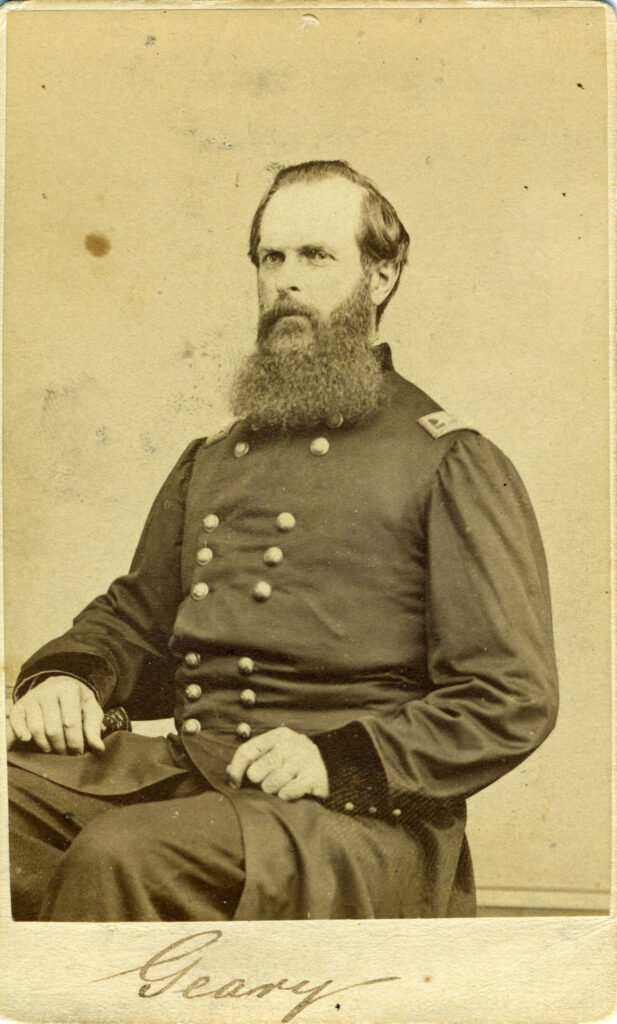Section #18 - After harsh political debates the Supreme Court’s Dred Scott decision fails to resolve slavery
Chapter 208: Governor John Geary Quells The Open Warfare In Kansas
September 9, 1856
Pierce Selects Colonel John Geary As The Third Territorial Governor In Kansas
As word of the latest bloodshed in Kansas fills the press, a desperate Franklin Pierce turns to a proven combat veteran in Colonel John Geary as the third Territorial Governor in Kansas.

Geary takes over from Acting Governor Woodson on September 9, 1856, making his first public appearance at Lecompton on the tenth.
By happenstance, his arrival corresponds with the release of Charles Robinson, the Free State Governor, from the city jail. Robinson has been imprisoned there since May 24 on charges of treason, but is freed in a deal worked out between congressional Republicans and President Pierce.
Geary himself is an imposing figure, standing six foot six, weighing 260 lbs. and exhibiting confidence in his own capacity to command, with good cause.
He is a Pennsylvanian by birth, a college graduate in civil engineering and law, and a member of the state militia in 1846 when the Mexican War breaks out. Commissioned a Lt. Colonel in the 2nd Infantry regiment, he is with General Winfield Scott when U.S. troops attack Mexico City. On September 13, 1847 Geary achieves lasting fame by leading a successful assault on the Belen Gate at Chapultepec Castle, while suffering five wounds in action.
Geary moves west after the war and enters politics in California, becoming the first mayor of San Francisco during the turbulent gold rush frenzy. He turns down an offer as Governor of the Utah Territory, but agrees to go to Kansas in support of the Democratic Party and the election of his fellow Pennsylvanian, James Buchanan.
He is committed to the principle of “popular sovereignty” and to insuring that it is executed in a legal and even-handed fashion. He announces this is his first address to the welcoming crowd in Lecompton on September 10:
Men of the North – men of the South – of the East and the West, in Kansas, you, and you alone, have the remedy in your own hands. Will you not suspend fratricidal strife? Will you not cease to regard each other as enemies, and look upon one another as the children of a common mother, and come and reason together?
Fall 1856
Geary Cracks Down On Violators On Both Sides
Behind Geary’s conciliatory words lie an iron fist.
Unlike his political predecessors, he is a military man and, if needed, intends to use force to restore law and order in the territory. He disbands the overtly Pro-Slavery Kansas militia and gains support from General Persifor Smith, commander of federal troops at Ft. Leavenworth. He also contacts Mexican War General Sterling Price, sitting Governor of Missouri, who agrees to keep the Border Ruffians in check.
His first challenges come quickly.
On September 14, a six hour skirmish matches Lane’s Brigade against a band of Atchison’s Kickapoo Rangers. The following day Geary becomes personally engaged when he rides toward Lawrence accompanied by federal troops and encounters a Pro-Slavery force preparing to once again assault the town. Geary backs them down immediately, saying they would first have to fight his army.
The prospect of facing U.S. troops led by Colonel John Geary sends both sides back to seeking victories on the political front.
With the Topeka legislature disbanded by Colonel Sumner on July 4, 1856, the “official” state government resides at Lecompton in the hands of Pro-Slavery men, who will soon discard their “Law and Order” label and associate themselves with the national Democratic Party.
On October 6, 1856 they oversee another vote to elect state officers, which is boycotted by the Free Staters – who, in turn, reconstitute their Topeka legislature on January 7, 1857.
Consistent with his pledge to be “politically impartial,” Geary irritates the Pro-Slavery side by vetoing legislation he finds improper. He also refuses to confirm William Sherrard, a particularly volatile native of Virginia, to succeed Samuel Jones as Sheriff of Douglas County, which includes the town of Lawrence. Sherrard is outraged, threatens to assassinate Geary, and fires his revolver at a hearing on February 18, 1857 to review his case. In turn he is shot and killed in the room by a Geary representative who happens to be at the meeting.
On the other hand, Free-Staters are inclined to also distrust Geary, believing that his support for the Democrats and Doughface Buchanan signals his underlying pro-slavery intentions. This is likely a misperception since he does befriend Charles Robinson and tends to criticize the Lecompton tactics in his reports to Pierce.
Geary is clearly the right man for the job in Kansas, if only he can tolerate the incompetence he finds with the politicians in Washington.